Cyclamen: Rules for Home Care
Cyclamens, with their delicate buds on thin stems, are so attractive and original that it is simply impossible to resist buying them in a flower shop. That is why this plant so often decorates the windowsills or flower pots in our homes. It is especially pleasing that cyclamens bloom in autumn and winter, uplifting our spirits during the most gloomy and gray days of the year. These graceful perennials will easily fit into any interior. You can quickly deliver indoor flowers to Troieshchyna by placing an order via the website, application, or by phone.
Cyclamen Types
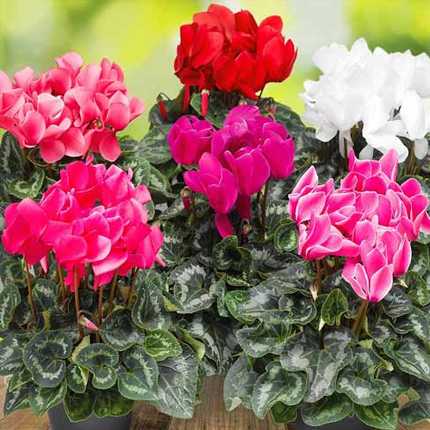
Today there are more than twenty types of cyclamen. And if in the old days only white and red varieties could be found on sale, today we can enjoy a wide range of cyclamen colors thanks to the breeders: from soft pink, purple, lilac, and ending with rich red. In addition, the buds of the plant were also somewhat modified: if earlier the petals were mostly smooth and even, now the corrugated frills with and without veins are not uncommon.
White Cyclamen
No matter how many new varieties have been bred, white cyclamen is still considered the standard of grace and elegance. This garden plant blooms in early spring. Its difference lies in the unusual structure of the buds: the soft white petals expand not in the center, but right at the base. In this case, peduncles (legs) can reach a height of 30 cm (~1 ft.) or more. The leaves of white cyclamen are silvery with a marble pattern. The stems with leaves can easily endure a frosty winter under a layer of snow.
European Cyclamen (Alpine Violet)
European cyclamen has medium-sized leaves and small buds with purple or pink petals. It is also occasionally found in white color. This plant variety is considered the most suitable for indoor conditions: it is not afraid of warm air, although coolness would be preferable, of course. There is no clear dormant period as such. The flowering time is at the end of spring – the beginning of winter. On summer days, the plant can be safely left on the loggia if protected from direct sunlight and pests such as insects, slugs, and worms.
Persian Cyclamen
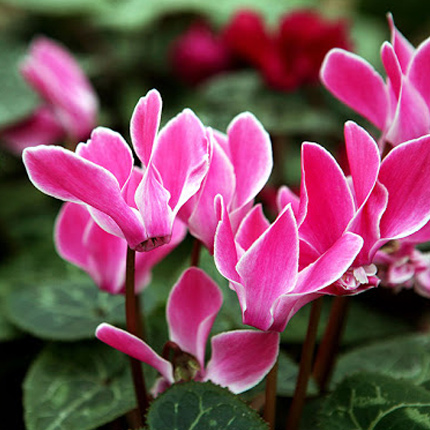
This is perhaps one of the most original types of cyclamen, which is very popular due to its amazing buds, which bloom with petals down, and not up, as if turning inside out. The most common colors of Persian cyclamen are pink and hot pink, lilac, and purple; the “throat” of the flower, as a rule, has a different shade. The leaves of this variety are large. Dwarf Persian cyclamens are often found these days; this modified variety does better at home. Both the dwarf and common species begin their flowering in late autumn and continue until early spring. The duration of the dormant period is 9 months.
African Cyclamen
African cyclamen is a fast-growing and heat-loving indoor flower. The flowering period of its pink (including rich pink and pale pink) fragrant buds occurs in spring – autumn, and the growth and development rate is very rapid. The leaves of this plant are quite large. They can reach 15 cm (~0.5 ft.) in diameter and have slightly silvery notes. It is worth noting that African cyclamens, unlike most of their relatives, shed their leaves for a dormant period. As mentioned above, this species is thermophilic, and it is afraid not only of the cold, but also of the sun, no matter how paradoxical this may be. If you are going to grow it not in a pot, but in a garden, then don’t forget about providing shade and a “dome” for the winter.
Greek Cyclamen
As the name implies, this type of cyclamen is traditionally native to Greece, but is also commonly found on the neighboring islands such as Crete and Cyprus, and on the Mediterranean coast of Turkey. The main peculiarity of Greek cyclamen is the unusual shape of its leaves: oval, heart-shaped, with a smooth border or a patterned edge. The color of the leaves is also unusual: green with spots and characteristic patterns. The buds come in all shades of pink, less often, purple.
Colchis Cyclamen
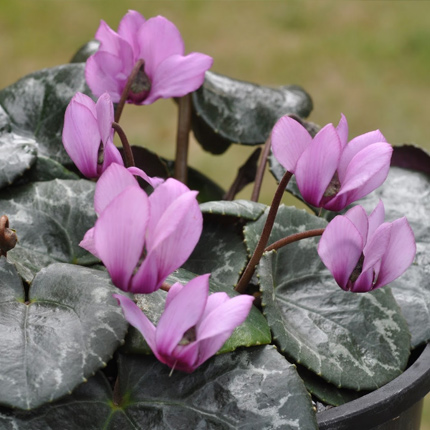
Colchis cyclamen has recently been classified as endangered and listed in the Red Book; therefore it is especially valuable. The massive reduction in the quantity is associated with its collection for medicinal purposes as well as for the bouquets. However, plantings of Colchis cyclamen are still quite extensive. It grows and develops considerably slowly, and its seeds ripen throughout the entire year. The buds are large and pink in color, with a more saturated shade along the edges. The flower’s aroma is quite strong. The leaves are medium in size, smooth, without any pattern. The best conditions for growing Colchis cyclamen are high humidity and plenty of shade.
Cyclamen Coum
The sunny Greek island of Kos is home to this variety of cyclamen, an ornamental plant with small, heart-shaped leaves. The beginning of flowering falls on the end of winter – early spring. Inflorescences come in a riot of colors: white, pink, rich pink, and red. The base of each petal is always slightly darker than the edges. The height of this variety is small: about 10-15 cm (~0.3-0.5 ft.). Due to the leaf length being approximately equal to the height of the entire flower, Cyclamen coum looks like a fluffy shrub.
Balearic Cyclamen
This plant is of small height and grows in the Mediterranean region, on Mallorca, and in the Pyrenees as its natural habitat. Balearic cyclamen is a rather hardy representative of the genus and can be grown in the open ground even in Eastern Europe. The leaves are blue-green with a silvery pattern, crimson on the inside. The inflorescences are most often white, sometimes light pink, with a light and pleasant aroma. The flowering starts in spring.
Neapolitan (Ivy-Leaved) Cyclamen

Neapolitan cyclamen is the most hardy, frost-resistant, and viable, being the most common one in the Eastern European region. These houseplants have attractive pink buds with a delicate, subtle fragrance. The inflorescences have small “horns” or “rosettes”. The leaves are rounded or oval, with small notches resembling ivy leaves (for which, in fact, the species received its second name). The flowering period falls on winter – spring. What’s more, the buds can begin to bloom either before the leaves appear or simultaneously.
Cyclamen Cilicium
Cyclamen cilicium is a mountainous, frost-resistant species. The optimal conditions are a dry, shady, and cool area. The plant has small leaves with silver spots, as well as soft pink buds with a richer base. The flowering begins in September.
Cyclamen Parviflorum
This delicate and small plant has short pedicels, small flowers with petals only 4-8 mm (~0.01-0.03 ft.) long, and small, rounded leaves. The inflorescences are most often purple and violet.
Turkish Cyclamen
A fairly popular houseplant with small glossy leaves and large buds in purple, lilac, red, or pink. The petals have a dark chocolate color at the base.
Cyclamen Care at Home
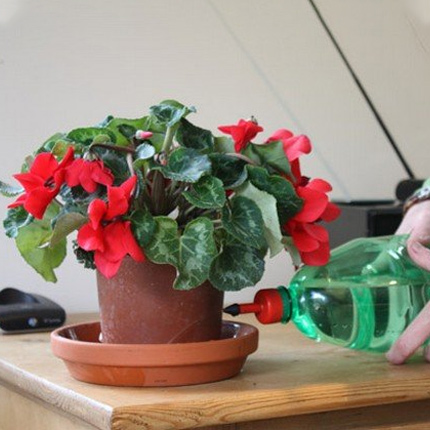
In order for cyclamen not only to survive, but to grow and develop at home, it must be regularly and properly looked after. Mistakes in care can lead to wilting and even premature death of the plant.
Watering and Humidity
Settled water should be used for cyclamens. If your area has increased water hardness, it is better to use distilled water. At the same time, keep an eye on the water temperature: it should be a few degrees lower than the general temperature in the room. The water volume should also be moderate to avoid waterlogging or drying out. Try not to get moisture on the buds and tubers; otherwise the decay process may begin. It is better to simply pour water into the pallet and put a flower pot on it. After 1-2 hours the pot can be removed. The frequency and volume of watering is reduced as the flowering period passes. During the dormant period (usually in summer), cyclamen should be watered extremely rarely. Gradually increase the liquid volume with the onset of autumn.
In addition to watering, pay attention to the overall air humidity. If the air is very dry, you need to periodically spray water. However, this should be done only before the buds appear. Note that the humidity level in the room can be slightly increased by placing flowers on a tray with moss.
Transplanting
Cyclamen transplantation should be carried out once every 2-3 years. As a rule, the old pot will become too small for the grown bulb during this period. However, the new pot should not be much larger than the old one; cyclamen develops well and blooms in a cramped space with a distance of about a few centimeters from the bulb to the walls. So, for a plant aged 1 to 1.5 years, a pot with a diameter of about 8 cm (~0.3 ft.) will be good, and for a two-three-year-old cyclamen, one with a diameter of 15 cm (~0.5 ft.). Schedule the transplanting at the end of the dormant period.
Cyclamen Transplanting Immediately After Purchase
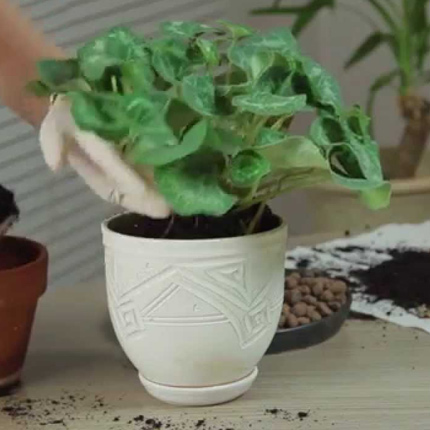
As mentioned above, you need to transplant cyclamen only during the dormant period, and it doesn’t matter if you bought it just now or some time ago. However, no one buys a mere bulb in the ground, as a rule. If you really want to replace the old pot with a new and more beautiful one, keep in mind that a flowering cyclamen must first bloom, then rest, and be transplanted just before the growing season. Still, if you see that the plant is quite comfortable in the same pot, it is better not to touch it, but simply put it in a stylish planter, for example.
Temperature and Lighting
The wellbeing of the plant directly depends on the place where you put the pot. For instance, white cyclamen needs sufficient (bright) lighting, but the sunrays should not be direct. Florists recommend placing it in partial shade on windowsills facing east or west. The flower will need shading on the southern side, and it will suffer from a lack of light on the northern one. As for the temperature, it should be in the range of 10-14°C (50-57.2°F) during flowering. In the summer, during the dormant period of the plant, the temperature should not exceed 25°C (77°F). Additionally, it is better to keep cyclamen in a shaded indoor area or plant it in a shady front garden for the season.
Fertilizing and Soil Requirements
Feed the plant once every two weeks with a special mineral fertilizer, from the moment the leaves grow until the inflorescences appear. The top dressing with nitrogen fertilizers can also be done, but you shouldn’t get carried away, otherwise the plant will simply begin to rot. The best soil for cyclamen is peat, humus, leaf soil, and sand with an acidity level of up to pH6. Exceeding this indicator will lead to the development of fungal infections.
Propagation and Cultivation

A plant such as cyclamen can be grown and propagated in several ways at home. The main condition is to do it correctly and in a timely manner.
Growing From Seeds
Seeds can be obtained in two ways: purchasing at a gardening store or taking directly from a mature plant. Plant the seeds in a pot with moist soil at a distance of about 3 cm (~0.1 ft.) from each other. Next, put the pot in a cool (about 17-18°C / 62.6-64.4°F), shady place, but rather cover it with a dark-colored film. If you comply with all these simple conditions, after 1-1.5 months you will be able to admire the first sprouts. After six months, these sprouts can be planted in different pots. The first flowering will occur no earlier than 1.5 years later.
Propagation by Dividing Tuber
This method can be applied only after the flowering stage. Carefully remove the bulb from the soil, dry it thoroughly, and cut it into several parts, sprinkling the cuts with charcoal (activated, wood, or any other antiseptic). At the same time, each part must have a bud and at least a few roots. After planting, place the cyclamen pot in a room where the temperature will not exceed 14-16°C (57.2-60.8°F). Water the plant regularly, but without overdoing it.
Propagation With Rosettes
You can only propagate European cyclamen (Alpine violet) with rosettes. The fact is that the rosettes (“horns” or shoots on tubers) don’t appear in all varieties. The growing process consists in tearing off the rosette from the tuber, planting it in a pot with moistened soil, and covering it with a bag, film, or simply a glass jar on top. The temperature conditions should be within 18-22°C (64.4-71.6°F).
Propagation With Leaves
This method cannot be called particularly effective, and it can only be applied to Alpine violets. Tear off a leaf with a small part of the bulb and put it in a cup of water so that the roots cut through. Next, transfer the plant into moist soil and cover with a jar. The first sprout will appear in 2-3 weeks.
Diseases, Pests, and How to Deal With Them
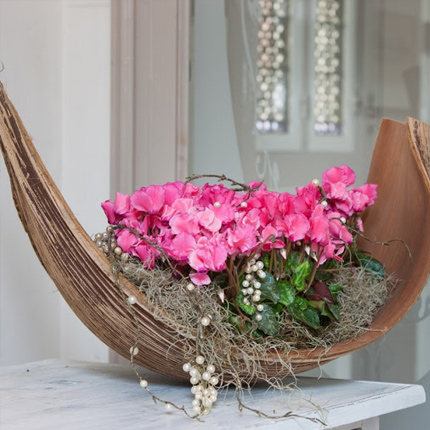
If you follow all the rules and recommendations for cyclamen care, no diseases or pests will threaten it. Otherwise, such unpleasant symptoms as rotting of the bulb (if the soil is waterlogged) or the appearance of spider mite (if, on the contrary, it was not watered enough), as well as a number of other diseases, may occur. Don’t make mistakes in the plant care, and cyclamen will make you happy with its health and incredibly beautiful flowering for many years to come.
In the meanwhile, let’s look at the main issues that may arise and learn how to deal with them.
Leaves Turn Yellow
First, analyze whether you are following all the rules and requirements for watering. If the answer is “yes”, and the leaves still begin to turn yellow, the problem is in the wrong temperature regime, as it is simply too hot for the flower. Move it to a shady, cool place and spray it with water from time to time; otherwise the buds will also begin to dry. What’s more, the yellowness on the leaves, which appeared after the flowering stage, may indicate that the plant has simply begun to prepare for the dormant period, so there is no reason to worry.
Cyclamen Doesn’t Bloom
You can forget about beautiful buds if you water the plant too rarely or don’t humidify the air in the room enough. Additionally, cyclamen will not bloom at temperatures that are too high for it, especially if you only recently bought it and the flower is simply not used to the new conditions. Over time, cyclamen can get accustomed to warm air and begin to bloom, but only if all other requirements are met.
Peduncles Are Too Short
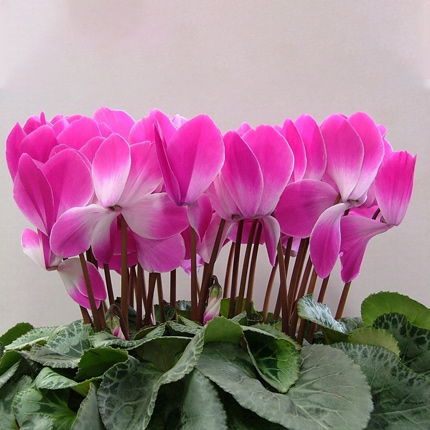
This issue is caused by the wrong watering schedule. It can be both excessive waterlogging and insufficient watering. Improper schedule plus the too low air temperatures cause the “legs” (peduncles) to grow short.
Deformed and Dry Peduncles
Most likely, your cyclamen has anthracnose: a disease caused by a soil fungus that affects the plant during the flowering stage. This fungus begins to develop in warm and humid conditions. The disease in the early stages may even be invisible until the peduncle sprouts. Affected peduncles look clumsy, and their top is dry; the flowering never occurs. If no action is taken, the leaves will be affected next: they will dry out, twist into a tube, and fall off. To stop the disease, adjust the watering schedule and humidity, tear off the affected leaves and peduncles, and treat the flower with a fungicide solution two to three times daily.
The Tuber Is Soft and Watery
This issue is also often accompanied by a cloudy coating on the leaves and peduncles, which can literally be scraped off with a finger. This means that cyclamen began to rot due to a fungus. The causes of rotting are the excessive watering and air humidity as well as the too low room temperature. It is possible to cure such a condition, but it will not be easy, and it is advisable to take decisive measures at the earliest stages. To begin with, cyclamen must be isolated, and then watered and sprayed with a fungicide solution according to the instructions.
Young Leaves Are Deformed and Coarse; Buds Are Covered With Brown Spots; Cuttings Are Brittle
All these symptoms indicate that the plant was struck by a multi-claw mite. To cure cyclamen, rub its leaves regularly with soapy water. You can also use specialized preparations: anti-pest sprays of a wide spectrum of action.
Leaves Are Covered With Yellow Dots That Are Easily Removed
Small dots are a manifestation of the disease at an early stage. In advanced cases, the leaves simply dry out, and the entire cyclamen gets covered with cobwebs. All this is due to the spider mite infestation. The insect appears on the flower because of heat and dry air. Cyclamen can be cured with insecticide solutions.
